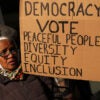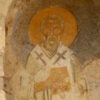126 years ago today, on June 17, 1885, the Statue of Liberty arrived in New York Harbor. A gift from the French people, the statue recalls our alliance with France during the Revolutionary War. Historian Edouard de Laboulaye conceived the idea of the statue as a visible symbol of America’s guiding principle: the universal liberty and equality of men.
Sculptor Frederic-Auguste Bartholdi designed the statue, modeling her after the Roman goddess Libertas, the personification of freedom. Officially titled “Liberty Enlightening the World,” the statue’s name, along with the torch born in her right hand, remind us of America’s mission: to be a city on a hill and a shining beacon of liberty for the world. As John Quincy Adams proclaimed on July 4, 1821, the United States is the “well-wisher to the freedom and independence of all.”
In her left arm, Lady Liberty cradles a tabula ansata, a tablet evoking the law. The tablet should remind us that the ideal of liberty is connected to the restrictions of law. Liberty is not license – rather, it is the proper exercise of freedom. The tablet bears the date “July IV MDCCLXXVI,” evoking the Declaration of Independence and the basis of our revolution: the unalienable natural rights of man.
On her head, she wears a seven-pointed crown, symbolizing the seven seas and seven continents. The crown points outward toward the whole world. This is the essence of American exceptionalism: that the torch of liberty shines not just for American citizens, but for all mankind. This idea is reemphasized in Emma Lazarus’ famous poem, “The New Colossus,” which is engraved in Lady Liberty’s pedestal. Lazarus’ poem specifically distinguishes the Statue of Liberty from the Colossus of Rhodes, “Not like the brazen giant of Greek fame,/With conquering limbs astride from land to land.” While the Colossus was built to celebrate the imperial dominion of the city of Rhodes, the Statue of Liberty was built to give hope to the world’s “huddled masses yearning to breathe free.”
Lady Liberty was delivered to the United States shortly after the close of the Civil War. Then and now, she reminds us that a nation conceived and dedicated to the proposition that all men are created equal can endure.
Kevin Burns is currently a member of the Young Leaders Program at The Heritage Foundation. For more information on interning at Heritage, please visit: http://www.heritage.org/about/departments/ylp.cfm





























2 Replies to “The Statue of Liberty Turns 126 Years Old”